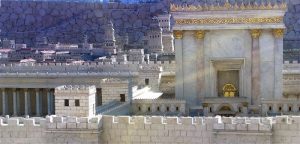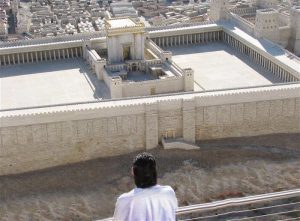The destruction of the temple in AD 70 was a devastating blow to Judaism, except for two groups: the Pharisees and the Christians. They were both able to cope with the new situation without many problems. Jerusalem and the temple were important to both groups, but the temple was not an essential, irreplaceable institution. It is of considerable symbolic significance that the representatives of both groups left Jerusalem during the years of the Jewish revolt. Yochanan ben Zakkai left the turmoil of Jerusalem to build Judaism anew at Yavne with his fellow scholars. The leaders of the Jewish Christian community made a temporary wartime refuge in Pella, east of the Jordan.
An interesting document that seems to have some connection with the Pella community has been preserved. It is part of the so-called Pseudo-Clementine Recognitions, book I:33-71 (written about AD 150). This document contains some similarities to Acts. Its beginning and end are missing, which is unfortunate – especially since the fragment ends just as Paul is about to meet the Lord on the road to Damascus. Apparently the writer disagreed with Paul and his mission, but had much praise for Jesus’ brother James.
The author draws a picture of salvation history beginning with Abraham and ending with the Jerusalem community under the leadership of James. He is friendly toward mission among Gentiles, but is himself mainly concerned with Israel. The author is a pious, law-obedient Jew, who accepts circumcision and the eternal validity of the Torah, except for one element: that portion which is concerned with sacrifices. These, he writes, were only temporary accommodations made necessary by the bad habit of offering sacrifices which the Israelites had acquired in Egypt. (There is rabbinic evidence that makes it almost certain that this theory is of Jewish origin, cf. Lev. Rab. 22:8, in the name of R. Levi.) Thus Moses began correcting the problem, “…leaving the other half to be corrected by another, and at a future time; by him, namely, concerning whom he said himself, ‘A prophet shall the Lord God raise unto you…’ (Dt. 18:15, 18)” (Rec. I:36). Moses made a partial correction by abolishing sacrifices to idols, Jesus abolished sacrifices altogether. The writer here has Jesus’ own sacrifice in mind. The atoning death of Christ is applied to the believer in baptism, and therefore the author states that baptism takes the place of sacrifices: “Lest they might suppose that at the cessation of sacrifice, there was no remission of sins for them, he instituted baptism by water amongst them, in which they might be absolved from all their sins on the invocation of his name…” (Rec. I:39). The devastation of Jerusalem, says the author, was a direct result of the sinful continuance of temple sacrifices after the appearance of Jesus.
There is evidence in Justin Martyr which suggests that the view of the sacrifices held by the author of Recognitions I:33-71 is actually much older than the passage itself. Therefore we may assume that this Judaeo-Christian document from the second century does not differ much in its view of the temple from that of the pre–AD 70 Jerusalem community.
From the very beginning, the apostles valued the temple as the place from which the authoritative Word of God was to go forth to all Israel and to the nations, according to Isaiah’s prophecy (Isa. 2:3). The earliest community was in the temple “day by day” (Acts 2:46). But what did they do there? We should note that with one exception, we never read of them bringing sacrifices. (The exception is Paul, who in Acts 21:23-26 is preparing to bring sacrifices for himself and four others in fulfillment of a Nazirite vow. Romans 3:25 clarifies that Paul attached no propitiatory quality to these sacrifices.)
What we do read is that they went up to the temple to teach and pray (Acts 3:1). We have already seen the significance of their teaching in the temple. Their praying there should probably be seen in the light of Jesus’ words when he cleansed the temple: “It is written ‘My house shall be called a house of prayer,’ but you make it a den of robbers” (Matt. 21:13). While the cessation of the atoning sacrifices posed a problem for the rabbis after AD 70, there is no trace in early Christian literature that this situation was ever considered a problem by the believers.
The faction led by James – presumably the whole Aramaic-speaking portion of the early community – seems to have completely ignored the sacrificial cult of the temple. This created tension between them and the Sadducees, and later with the Diaspora Jews who were zealous for the temple. The early Jerusalem  community seems to have regarded the temple as the supreme synagogue, the ultimate place for teaching and praying. The remission of sins was no longer obtained by the sacrifices offered there, but by the supreme sacrifice of Christ. In 1 Corinthians 15:3ff, Paul passes on a tradition probably derived from the earliest Jerusalem community, in which the sacrificial death of the Messiah is already spoken of in unambiguous terms.
community seems to have regarded the temple as the supreme synagogue, the ultimate place for teaching and praying. The remission of sins was no longer obtained by the sacrifices offered there, but by the supreme sacrifice of Christ. In 1 Corinthians 15:3ff, Paul passes on a tradition probably derived from the earliest Jerusalem community, in which the sacrificial death of the Messiah is already spoken of in unambiguous terms.
Oskar Skarsaune
This article is adapted from material written by Dr. Oskar Skarsaune for Caspari Center’s Messianic Teaching Program (TELEM). In the 1980s and ’90s, Caspari Center published several study books for this program, among them The Jewish Roots of the New Testament and Jewish Influences in the Early Church by Dr. Skarsaune. He further developed and deepened this material into an excellent book, In the Shadow of the Temple. To purchase In the Shadow of the Temple, click here.